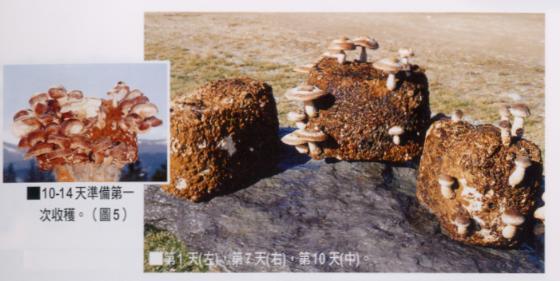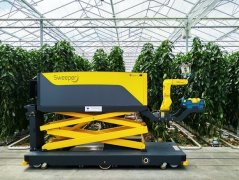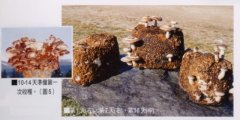Practical cultivation techniques of Lentinus edodes and new techniques for fast-growing and high-yield cultivation of Lentinus edodes
Lentinus edodes, known as Lentinus edodes, is a low-calorie food. If you eat 50 grams of Lentinus edodes a day, you have only 15 calories. Eggs are also high in self-quality and fiber, and rich in calcium. In addition, Lentinus edodes also contains two ingredients that have been proved to be effective, namely Lentinus edodes mycelium extract (LEM) and lentinan (Lentinan), which are sold commercially at present.
In 1969, the Japanese government conducted a survey on two areas with very low cancer rates and found that these two areas were the production areas of Lentinus edodes in Japan, and residents consumed more shiitake mushrooms on a daily basis. Lentinus edodes has been recognized as a health food in the world.
Lentinus edodes production in Taiwan is mostly concentrated in Nantou, Taichung and other areas. According to the 1989 Agricultural Annual report, the production of Lentinus edodes in Taiwan is about 3166 metric tons. At present, there is no suitable benchmark for the production of organic shiitake mushrooms in Taiwan, but if Lentinus edodes is classified as organic vegetables, we must adopt an all-organic mode of production, that is to say, the production process of organic Lentinus edodes can not use chemical fertilizers and pesticides at all. Lentinus edodes cultivation generally uses fewer pesticides, so Lentinus edodes is suitable for organic cultivation of agricultural products.

Organic cultivation of Lentinus edodes
Lentinus edodes is easier to cultivate organically than other mushrooms because it is more resistant to diseases and insect pests. In Europe and the United States, many cultivation of Lentinus edodes is organic, that is to say, Lentinus edodes is cultivated by using wood or sawdust, without adding chemicals such as calcium carbonate or pesticides to the cultivation medium or spraying pesticides on Lentinus edodes. The organic cultivation of Lentinus edodes will encounter some problems of miscellaneous bacteria and diseases and insect pests in the traditional cultivation of Lentinus edodes, such as slug, mushroom fly and so on, which will lead to the reduction of yield or affect the quality of Lentinus edodes. Producers must be able to control these diseases and insect pests or face some degree of loss of harvest. In order to identify "organic", the producer must participate in the certification.
The traditional cultivation of Lentinus edodes is mass cultivation and commercial production. In recent years, some organic Lentinus edodes production companies in the United States have promoted the Organic mushroom growing kit of organic Lentinus edodes on the Internet. In the United States, there are also examples of selling small pieces of wood for people to grow mushrooms at home. Small pieces of wood inoculated with the mycelium of Lentinus edodes can be used indoors or outdoors in shaded to produce natural organic shiitake mushrooms. This kind of wood is said to be used continuously for 3-4 years, about every 2 months, as long as it is well taken care of.
Organic mushroom bag
Missoula is a small town in Montana, USA, also known as Garden City (GardenCity). The GardenCity farm in Missoula, which is named after Garden City, is jointly operated by GIen Babcock and Wendy Garrett. This fungus farm is famous for producing certified organic mushrooms. They also boast that they can provide small bags for family production of mushrooms. This allows many laymen to produce shiitake mushrooms in their own homes. The strain of Lentinus edodes they use is suitable for growing at 15-24 degrees Celsius. Using the organic mushroom production package of the farm to grow Lentinus edodes at home is as easy as growing potted plants at home. all you have to do is water. When you receive a small bag, it is like receiving a strange gift, and it seems to be an educational plan for you to learn and understand.
The sawdust bag used to produce Lentinus edodes does not take up space. It is only 15 centimeters by 15 centimeters and can be placed on a coffee table, cabinet or desk. It is extremely exciting to observe the growth of Lentinus edodes every day.
How to take care of Lentinus edodes at home
To successfully grow Lentinus edodes at home, it is nothing more than to let the mushroom bag indirectly shine on the light, supply water and air at an appropriate time, and also to pay love. In general, the mushroom bag cultivated at home will be accompanied by three other things, namely, the moisture retention account, the wooden bar supporting the moisture retention account, and the care card (that is, the instructions for the use of the mushroom bag).
The method of using sawdust plastic bags to produce Lentinus edodes in Taiwan was published in about 1974. after continuous research and development, it has developed into a world-famous and special mode of production (Song Xie, 1998), which is what the people call "space bags." its materials are mainly made of cornwood chips, rice bran, corn flour and calcium carbonate. For the sawdust plastic bag used in the cultivation of organic Lentinus edodes, the calcium carbonate should be crushed by minerals containing lime, and the addition amount should also be properly discussed. excessive amount will slow or even hinder the growth of mycelium. The following is the method of producing Lentinus edodes according to the self-production methods provided by the Garden City Culture facilities for domestic reference:
1.
When you receive the mushroom bag, the sawdust medium has been adjusted and Lentinus edodes has been picked up. All you have to do is take out four pieces of wood and insert them on the four corners of the big square (figure 3), and then cover the attached plastic bag as a moisture maintenance account (figure 4). Mushroom bags should be kept at a temperature of about 16 to 21 degrees Celsius and should be exposed to light for about 10 to 12 hours a day.
two。
Keep enough moisture in the account so that Lentinus edodes can grow well. It is usually enough to spray with water spray four times a day. Water spray is sprayed to the inner wall of the moisture tent with water droplets, indicating that there is enough water.
3.
Usually spray water twice a day, about 7 to 10 days you should be able to see the mushroom has begun to emerge from the big square.
4.
When shiitake mushrooms continue to grow, you must keep the moisture in the account relatively high so that you can harvest. Lentinus edodes has no skin, and its water evaporates quickly, so it must provide sufficient water.
5.
When the mushroom cap has flattened slightly, you can harvest Lentinus edodes. (figure 5)
6.
When all the mushrooms are harvested, it needs to rest for about 10 days so that the hyphae can absorb nutrients again so that the mushrooms can emerge again next time.
7.
During the rest of the mushroom pieces, you must continue to water them.
8.
After letting the mushroom pieces rest, they must be stimulated to grow mushrooms again. So remove the moisture curtain, also remove the four sticks, and soak the mushrooms in cold water (about 13-16). C) in the bucket, let it completely immerse in the water for about 18-24 hours. You can press the mushroom block with something to keep it from floating dirt.
9.
After soaking, put the mushroom pieces back into the moisture tent again, and then spray and water them again. Usually the next batch of mushrooms will emerge again after 7 to 10 days.
10.
Repeat the above steps until no more mushrooms are produced. Generally speaking, the life span of mushroom pieces depends on how well you follow the instructions to manage them. As long as you pay attention to watering, standing, soaking and growing mushrooms, you will get a good yield of Lentinus edodes.
11.
Usually, when the outer edge of the mushroom changes slightly, the shiitake mushroom can be harvested. The size of mushrooms is generally not uniform, but between 5-10 cm. In general, if Xiangru is well managed after harvest, the number of reissued mushrooms will increase, but will become slightly smaller. In order to keep the moisture in the account, you can put a small bowl of water in the moisture account, which can increase the moisture in the account and is beneficial to the production of mushrooms. Usually, the mushroom pieces can continue to produce Lentinus edodes after about 2-3 weeks, while the whole mushroom pieces can produce mushrooms for about 2-3 times. Lentinus edodes produced for the first time will be larger than those produced for the second or third time.
- Prev

Precision agriculture in Israel, invented the sweet pepper picking robot Sweeper
Rest assured that robots will not be able to occupy our world in the short term, because even the most basic operational tasks will leave them at a loss as to what to do. Have you ever thought about how difficult it would be to let a robot pick a mature bell pepper by itself? Honestly,
- Next

Practical cultivation techniques of Lentinus edodes and new techniques for fast-growing and high-yield cultivation of Lentinus edodes
Lentinus edodes, known as Lentinus edodes, is a low-calorie food. If you eat 50 grams of Lentinus edodes a day, you have only 15 calories. Eggs are also high in self-quality and fiber, and rich in calcium. In addition, Lentinus edodes also contains two ingredients that have been proved to be effective, namely incense.
Related
- A one-day flower show brings 130 million yuan in orders! Nanhai, this Phalaenopsis exhibition is amazing
- What do the flower language and meaning of Lutheran tree mean? Precautions for planting Lutheran tree
- Encounter Chaoshan Kongfu tea, not without this cup of Phoenix single clump
- The durian market in Vietnam and Thailand is flooded. The price of imported durian has plummeted by 30-40% in a month.
- Shanghai solved the problem of local vegetable supply by planting 80,000 mu of green leafy vegetables.
- Wageningen University has become the best agricultural university in the world for the seventh time in a row.
- The strongest export season of South African grapes is full of challenges, with exports to Russia falling sharply by 21%.
- Sri Lanka is on the verge of bankruptcy, "Tea for debt" Organic Agriculture Revolution aggravates the Food crisis?
- Turning waste into earthworm manure and worm manure into organic fertilizer-A new choice for auxiliary farming
- Organic rice growers shoulder the responsibility of nurturing agricultural talents! Yinchuan Sustainable Farm with Organic Life Camp

